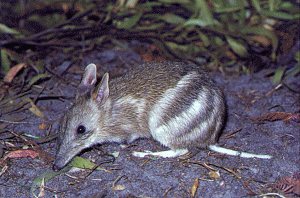Mainland Forgotten Fauna Part 12: Tasmanian research provides new clues on what went wrong on the mainland… and what we could do next
It has been a little while since the last Mainland Forgotten Fauna instalment – Part 11 – where we looked back at the time when the stony rises of western Victoria were teeming with quolls.
This was also an era when western Victoria was the hub of the mainland’s population of the Eastern Barred Bandicoot, an originally common species of the Victorian Volcanic Plain.
So it was with great interest that I read a recent article on ABC news – see link here – discussing the latest published research to come out of Tasmania. (The original journal article is available here for purchase if you want to read the abstract or read the full paper).
In a nutshell, this research gives strong clues as to how Devils have protected smaller native mammals in Tasmania by reducing feral cat abundance – noting that feral cats are an introduced predator that have been around in Tasmania for over 200 years, since the earliest days of settlement, and yet Tasmania has not experienced any small mammal extinctions. This includes some of the very same native mammal species that suffered precipitous declines on the mainland.
This finding also complements earlier research that showed the presence of Devils can modify feral cat behavior – see here for the NGT blog on that story.
The most recent paper shows how this apparent ‘protective effect’ from the impact of feral cats is now being lost or reduced in areas where Devils have declined as a result of facial tumor disease, and, as a result, Tasmania itself is now also experiencing declines in the very species of fauna that we have already seen disappear or decline substantially on the mainland.
So it turns out the Devil is a pretty amazing keystone species, and its importance is not to be underestimated.
Not only is it the remaining apex (top) marsupial predator we have left in Australia (since the extinction of the Thylacine), but when this species is in healthy numbers within an ecosystem, its very presence also makes that ecosystem more resistant to the impacts of introduced ferals. That in turn allows our other co-evolved small marsupials to hang on – in Tasmania this has occurred even with cats in the landscape, over a long period of time when they were not specifically controlled by humans. After all, for most of the past 200 years there was simply no need to control cats in Tasmania to protect other small mammals, because it turns out that Devils have been doing that job for us all along!
The ecological term for an apex predator causing a series of direct and indirect impacts that ‘trickle down’ through an ecosystem is trophic cascade.
This is a very important topic in ecology that is worth us thinking deeply about, given the history of native predator suppression in Australia. Indeed, the evidence in support of seriously testing this concept (and what this could mean for ecosystem function across the mainland) is mounting.
After all, imagine if the return of Devils to a trial area on the mainland proved that it would be feasible to bring back a suite of species we thought we would never see again outside of fence exclosures – like the missing mainland species of quolls, bettongs and bandicoots?
If we just think outside the square, our missing guild of marsupial predators – led by the Devil – could be the key…


